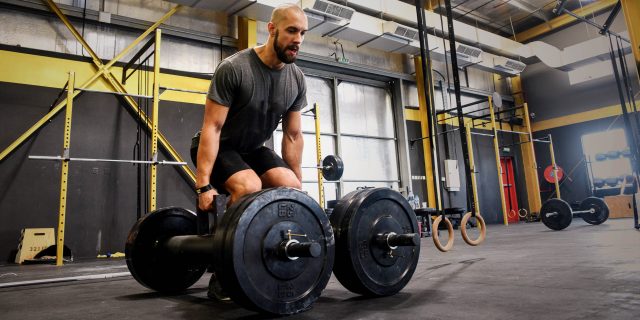Lifehacker tells you how carrying weights will improve your fitness and shows you seven good exercises.
You can lift a 250-pound barbell, but when you’re asked to move a closet, it will seem like an unexpectedly difficult task. Lifting weights and carrying weights are two different activities, and it’s worth combining them in your workouts.
Why lifting weights is easier than carrying them
Lifting and carrying weights use different motor patterns and different muscles. When you lift weights, the movement is as simple as possible – up and down. Walking with the weight causes you to strain more muscles to keep your balance and hold an object, especially if it’s something uncomfortable to carry.
The body is under strain longer while carrying weights. To lift a heavy barbell once, you need to make a simple movement. Yes, it will be hard, but that will be the end of it. When you carry a heavy sandbag 45 meters, your body spends much longer under load.
However, one type of workout does not preclude the other. To carry heavy weights, you first need to learn how to lift them.
Why you should carry weights
Develop functional strength. This is what will come in handy in your everyday life. For example, you’ll carry your children when they’re tired or asleep, get home with heavy shopping, carry weighty bags when you’re renovating or working in the cottage. If you want to do all these things easily, incorporate weight lifting into your workout routine.
Work out different muscle groups. Weight carrying develops core muscle strength, increases stability of the hips, and trains grip strength, an often underestimated parameter that directly affects any movement with the weight.
Increasing the athlete’s capacity. A person who carries weights increases his or her endurance and can train longer and more intensely.
Development of stability. You can remain stationary under external influences. For example, not bending under the weight when carrying two weights.
Adapting your skin and soft tissues to the effects of weight. If you exercise with a barbell and a chinning bar, only the skin of the palms gets used to the impact, but when you carry heavy stones and bags, the skin and soft tissues of the shoulders and chest also adapt.
How to carry weights
You can perform exercises with kettlebells and dumbbells, but the comfortable form of the equipment will not prepare you for what you will have to face in life. To develop functional strength, diversify your workouts by carrying other objects, not only heavy, but also uncomfortable: bags, large rocks or even people.
What weight to use
It all depends on your goals. The lighter the object, the farther you can carry it and the more you develop your endurance. The heavier the weight, the shorter the distance and the better the strength is pumped.
Experiment with different weights and objects to find the perfect load. Be sure to follow proper technique: carry the objects with a straight back, and distribute the weight more or less evenly on both sides of your body.
How often to train
Have a weight-carrying workout once a week, doing one or more exercises at the end of your regular workout. If you’re exercising for strength, increase the weight and/or distance each week. If you want to increase your endurance, combine different exercises and note how much you can do before you get tired.
Exercises
1. “Farmer’s Walk.”
Take dumbbells or kettlebells in both hands and walk as much distance as possible with them in 30 seconds. For your next workout, walk for 45 seconds, then walk for one minute.
2. “Farmer’s Walk” with a weight in one hand
The exercise is similar to the previous one, but you only carry the weight in one hand. This makes it more difficult because your body has to use all your cortical muscles to keep your balance.
You carry the weight in one hand, then change hands and do the same thing. Start with 30 seconds per exercise for each arm and gradually increase to one minute.
You can combine the exercise with a “farmer’s walk”: carry one weight or dumbbell in the lowered hand and the other in the raised hand above your head.
3. Carry the shells above your head
Lift dumbbells above your head and carry them for 30 seconds. Increase the time by 15 seconds until you reach a minute.
4. “Waiter.”
Do the same as the previous exercise, only keep the weight in one hand. Perform for 30 seconds on each hand and gradually increase the time to one minute.
5. Carrying a sandbag
You can find a sandbag at the gym, but they are not available everywhere. If you work out at home or in the garage, buy a bag or make one yourself.
Mark 20-25 meters and walk with the bag as fast as possible. You can carry the bag on your shoulder, in a hug or a combination of these methods. Repeat the walk 5-10 times at the end of the workout.
6. “Fireman.”
This movement can help you in emergency situations when you need to carry an injured person. To perform this movement habitually and easily, you need to train exactly with a person on your shoulders, not with a heavy bag or something else.
7. Walking with a backpack
You simply put on a heavy backpack and walk with it. The exercise doesn’t involve your arms, but it puts stress on your shoulders, torso, and legs. It’s good cardio that doesn’t put much strain on your knees, unlike running or jumping.
Combine exercises with each other
Choose three exercises from the list and do them at the end of your regular workout. For example, starting with a 30-second “farmer’s walk,” then moving on to carrying a sandbag and ending with carrying dumbbells or weights over your head is a great workout for building endurance and functional strength.

